DAY 2 – CASTELLI ROMANI
Benvenuti in Italia, welcome to Italy.
The area south of Rome is known as “Castelli Romani” (Roman Castles). The entire area originated from a series of volcanic eruptions that shook an original crater, creating some lakes. The area, a traditional destination for the out-of-town excursions of the Romans, is dotted with several pretty hill towns famous for their ancient history and highly regarded wine: Castelgandolfo, the summer residence of the pope, Rocca di Papa and Grottaferrata, known for their culture and gastronomic delicacies, Frascati, famous for its breathtaking views and its sweet and refreshing white wine named after the city, are only some of them.
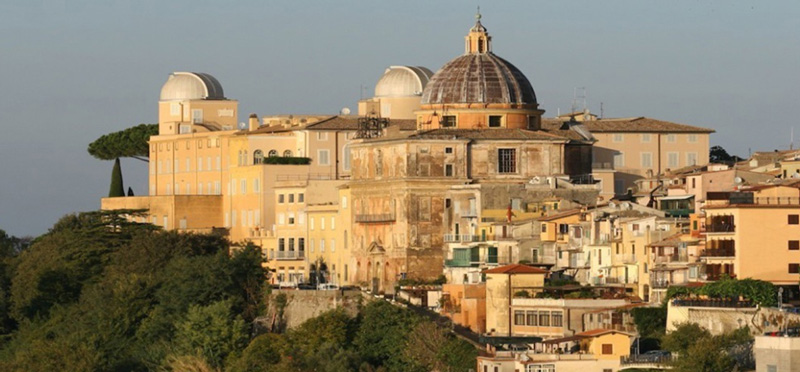
DAY 3 – AMALFI COAST
Welcome to the Amalfi Coast!
Costiera Amalfitana is Italy's most scenic stretch of coastline, a landscape of pastel-coloured villages terraced into hillsides, steep panoramic roads, luxuriant gardens and enchanting vistas over turquoise waters and green mountains.
Considered by UNESCO "an outstanding example of a Mediterranean landscape, with exceptional cultural and natural scenic values," the coast has been a World Heritage Site since 1997. You may go from town to town at the discovery of Amalfi, Positano, and Ravello, three of the most beautiful villages in Southern Italy, world-famous for their charm and colourful architecture.
Amalfi typically has Mediterranean architecture with lanes and characteristic white houses piled one upon the other. In the Middle Ages, it was one of Italy's four powerful maritime republics (with Venice, Pisa, and Genoa). All sea trade in the Mediterranean was once governed by the 12th century “Tavole Amalfitane”, one of the world's oldest maritime codes. A must-see in Amalfi is the Duomo di Sant'Andrea, fronted by an intricately patterned façade, redone in the 19th century. Founded in the 9th century, the Cathedral's subsequent alterations have spared its principal glory, the main portal's 11th-century Byzantine bronze doors. Next to the church lies the Chiostro del Paradiso (1268), or Cloister of Paradise, whose serious Romanesque tone is animated by the Arab elements in its sinuous columns. To escape the bustle of Amalfi, let’s take the famous walk along the “Valle dei Mulini”, a steep-sided valley dotted with ruined watermills – “i mulini” - once used to make paper, an industry for which Amalfi was, and still is, famous.Here you will enjoy a particular “Lemon Experience” with our friend Salvatore, the owner of the biggest lemon farm in Amalfi, who will introduce you to all the secrets of lemons and limoncello.
Positano sits in a splendid panoramic position on one of the most beautiful stretches of coastline. Its enchanting town centre of delightful pastel-coloured houses surrounds the parish church of Santa Maria Assunta; its streets are lined with quaint, colourful shops, and its numerous beaches are world-famous.
Ravello is more elevated than the other pearls of the Amalfi Coast, boasting exceptional views of the coast and its marvellous villas and gardens. French novelist André Gide said they are “closer to the sky than the sea”. Here you may visit Villa Rufolo, built in the 13th century, which hosted popes and kings, and Richard Wagner, who composed part of his opera Parsifal here in 1880. Views from its idyllic gardens are magnificent!
A trip to Cetara is an absolute must. The village is renowned for a particular gourmet speciality, “colatura di acciughe” (anchovy sauce), produced according to an ancient procedure for generations. Spaghetti with colatura di alici is the area's typical recipe, a dish you will remember forever. Discover the secrets of the liquid gold of the Coast in the article in our BLOG.
If you are in the mood for hiking, the “Path of the Gods” climbs the mountain above Positano, which offers absolutely stunning views over the coast and Capri. Above Praiano, you may also engage in a unique guided Gastronomic Trek, picking natural herbs you will use in a most unusual cooking class led by your guide/cook.
At dinner, don’t miss Spaghetti with clams in olive oil and garlic sauce, or Seafood Risotto, with a glass of excellent Greco di Tufo white wine.
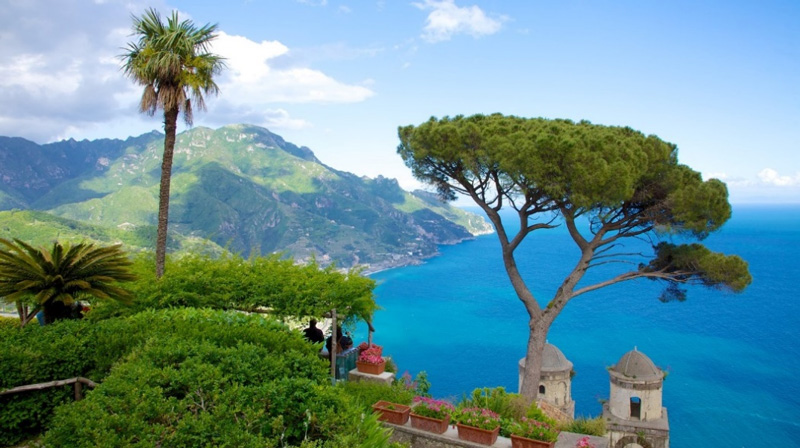
DAY 4 - CAPRI
With a steep, jagged coast and encircled by the famous “Faraglioni” (sea stacks), enormous and uniquely shaped boulders, and by numerous caves that tell of evocative plays of light, Capri offers a landscape of wild beauty sculpted by wind, sea and the hand of man. The most famous of these caves is the “Grotta Azzurra” (Blue Grotto), closely connected to the history of tourism in Capri.
Its discovery by the ancient Romans is hinted at by countless archaeological finds - e.g. Villa Jovis, whose construction was commissioned by Emperor Tiberius.
The island continues to be both a legend and a favourite destination for travellers, intellectuals and the international jet-set - "performing" at any given time in the legendary “Piazzetta”, the real-time theatre of the island's 'Dolce Vita'. Beyond sea and nature in all their charm, Capri offers many chances for excellent shopping: elegant boutiques and artisans' studios selling “Made in Italy” items and typical products alternate along the characteristic sidestreets and alleyways. Moreover, the flavoured local food is tied to the island's maritime and peasant traditions.
The island is associated with the myth of the Sirens due to the presence of the homonymous rock of the Sirens characterizing the bay of Marina Piccola. Servius's commentary on the 5th song of Virgil's Aeneid is among the sources that feed the legend. The poet narrates half-bird and half-woman creatures that would have lived in Capreae and who, with their songs, bewitched the sailors and sent them against the rocks. On the other hand, the physical conformation of the island, made of coves, caves and precipices, makes it perfect as a refuge for these mythological beings.

DAY 5 – PAESTUM
Located in the South-East of the Gulf of Salerno, Paestum is an archaeological site of extreme importance, recognised by UNESCO as part of the World Cultural Heritage. Built by the Greeks around the 7th century BC with the name of Poseidon, the city was later occupied by Romans, who made it a thriving colony, giving it its current name.
In addition to its cultural value, the importance of Paestum is linked to the excellent state of conservation of properties, starting from its walls, built by the Greeks and later strengthened by the Romans. Inside them, three majestic temples on a green plain reflect a different light depending on the hours and seasons. Many writers, poets and artists like Goethe, Shelley, Canova and Piranesi were fascinated by this sight, which later inspired them for their works.
These large buildings are a remarkable example of Doric-style architecture. The Temple of Hera, dating to the 6th century BC, is the most ancient building. The Temple of Neptune (5th century BC) is a massive construction made of travertine marble in a warm golden colour that varies at different times of the day. The Temple of Ceres (6th century BC), dedicated to the goddess Athena, was transformed into a church back in medieval times.
Besides its temples, Paestum is famous also for a gourmet speciality that you should taste on site: its “mozzarella di bufala”. Made with the best buffalo milk from the area, “mozzarella di bufala” is closely linked to the land of Campania; the skill it is made reflects the love the cheesemakers put into creating this Italian excellence. We will visit a cheese factory in the area to understand how it is created and taste it freshly made, an unforgettable experience!
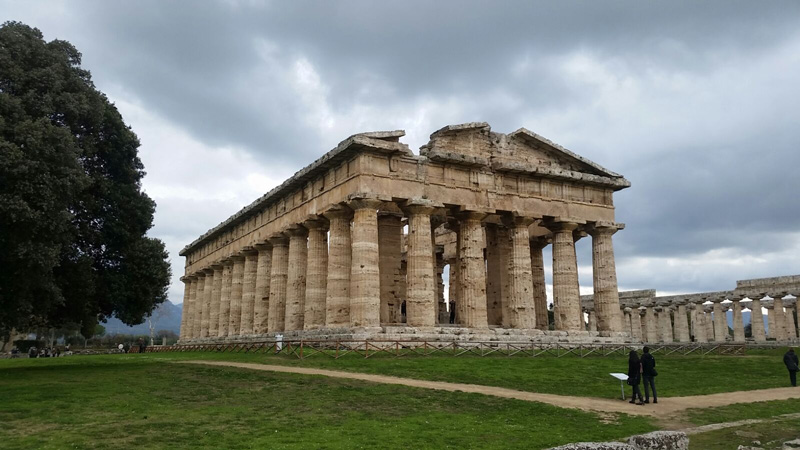
DAY 6 – MATERA
Matera is one of the oldest cities in the world, whose territory holds evidence of human settlements starting from the Paleolithic and without interruption until today. Touring Matera is like experiencing a forgotten past - you feel like setting foot in a nativity scene when you visit this charming city in Lucania. It’s no coincidence it’s referred to as “the second Bethlehem” and was the setting for Mel Gibson’s movie “The Passion” and the last James Bond, “No time to die”.
Matera is widely known as the city of the “Sassi”, the original urban nucleus, developed from the natural caves carved into the rock and subsequently modelled in increasingly complex structures.
In the 1950s, when the inhabitants who lived in the caves dug out of the mountain were forced to abandon those dwellings to settle in modern districts, no one would have ever thought that those grottos - the Sassi - would have become the symbol of a reborn city. UNESCO added the Sassi of Matera to its list of World Heritage Sites in 1993 as a whole and a millennial way of life to be preserved and handed down to our descendants. In fact, it was recognized as a model for living harmoniously with the environment while integrating with it and taking advantage of resources without disturbing the environment.
Geologists call it calcarenite, and ordinary folk refer to it as “tuff”: it’s the rock surrounding Matera that this land’s master artisans learned to work with in ancient times. This brittle, adaptable material is abundant in the mountain that dominates the city, so it seemed only natural for the people from Matera to go up there and dig out that rock to build a home. The extracted material was processed to make the façade of the dwelling. After the first home, others were constructed until the network of houses, tunnels and alleyways became that magical place called Sassi - a gigantic sculpture, a miracle of town planning!
In Matera, you’ll discover one of the most beloved Italian breads. “Pane di Matera" is a bakery product for which only hard wheat semolina and sourdough are used. The characteristics to recognize the bread of Matera are the shapes, croissant or high bread, and a straw-yellow crumb. But besides bread, you’ll not miss other local specialities such as the Caciocavallo cheese or the “Lucanica” sausage.
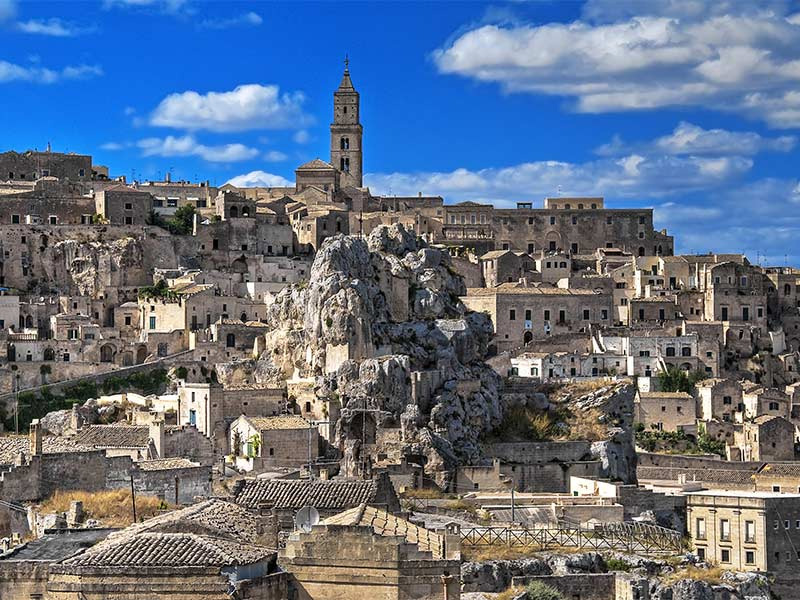
DAYS 7 & 9– ALBEROBELLO & MARTINAFRANCA
The Trulli are famous worldwide for their beauty and unique characteristics and represent one of the most extraordinary examples of Italian folk architecture. They were built in a particular historical period when the construction of stable dwellings was highly taxed; the region's inhabitants thus boasted a great capacity to adapt and an exceptional cleverness in coming up with the Trulli, temporary houses built with the local stone. From precariousness to stability - the process of transformation and recovery and the deference to the originality of the work earned the Trulli of Alberobello their recognition as a World Heritage Site.
In Alberobello, the capital of the Trulli, each Trullo has a different shape and size. Unique constructions are sometimes combined in a complex of communicating houses, while others are built on two levels. Most feature a grey cone-shaped roof, ending with a sphere or hemisphere shape. The interior, arranged as a single chamber, comprises niches for a fireplace, bed and furniture. The structure assures excellent indoor climate control: cool in summer and warm in winter!
Martina Franca is a charming baroque town 400 metres above sea level. The era of greatest splendour for this city was undoubtedly the 18th century when the most important monuments and churches still dominating the historic centre were built. Baroque is the predominant style; it can be seen in many buildings, and in this city, it has taken on characteristic connotations that distinguish it from the other variations of this artistic and architectural current; in fact, we speak of “Martinese” Baroque.
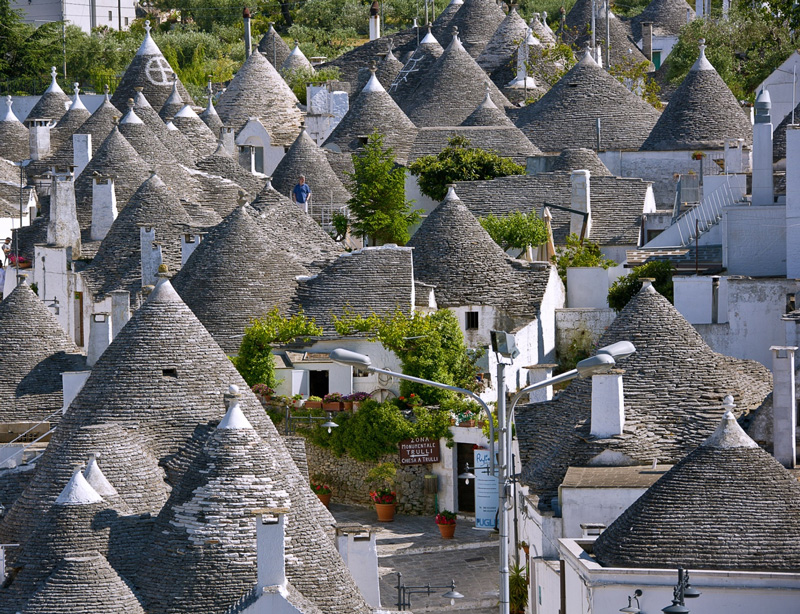
DAY 8 – LECCE
Lying on a plain at the foot of the Salento Plateau is Lecce - the "Florence of the South" - one of the most exciting cities in the region for its architecture, typical of the 17th century.
Of ancient origins, the city experienced two distinct periods of prosperity: the Roman era and the Kingdom of Naples. Under both, the construction of buildings, monuments and mansions increased heavily. These new structures were characterized by magnificent and rich ornamentations that earned this typical architecture the definition of “Leccese Baroque". The imaginative and meticulous sculpting work was facilitated by the fact that the local stone is flexible and easy to inlay. A visit to Lecce can begin with Piazza Duomo, once used as a fortress and today considered the most elegant "salon" in the city. The grandeur of the Duomo, the work of Zimbalo, Cino and Penna, the five-story-tall bell tower, the Palazzo Vescovile (Bishop's Palace), and the Palazzo del Seminario (Seminary) mark the perimeter of the square, one of the monumental works that best represent the magnificence of Lecce’s style.
Not far away, Piazza Sant'Oronzo narrates the city's entire history. The Roman period is visible in the ruins of the Amphitheatre that becomes the exceptional stage for theatrical performances in the summertime, and in part by the high Column - on which stands a bronze of St. Orontius, depicted in the act of blessing - erected in the 17th Century utilizing some of the Roman columns positioned on the Ancient Appian Way. Palazzo del Seggio, known as the "Seat," hosting important art exhibitions, and the Church of Santa Maria delle Grazie, with its interesting frescoes and works sculpted in wood, are the very symbols of the Apulian Renaissance.
Not to be missed is a visit to the Basilica di Santa Croce, where the inspiration of master masonry is visible in every part of the monumental façade that anticipates the beauty of its interior, a harmonious balance between the sobriety of the classical style and the splendour of Lecce's Baroque.
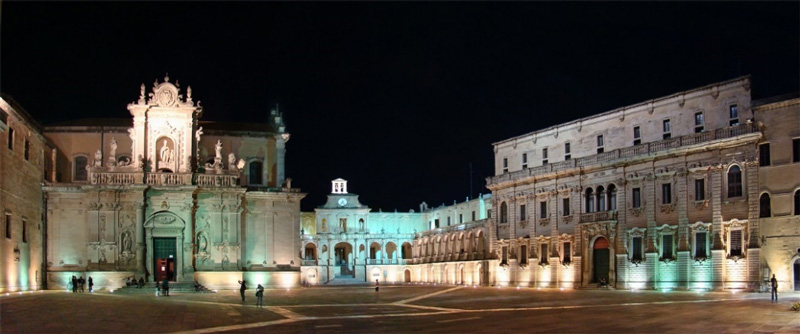
DAY 10 – CASTEL DEL MONTE
Recognized as a World Heritage Site in 1996, Castel del Monte is a brilliant example of medieval architecture located on a hill in the Murge area. Commissioned by the eclectic and cultured Frederick II, Duke of Swabia, Emperor of the Sacred Roman Empire, the Castle is an exceptional work for the perfection of its forms and the fusion of cultural elements from different periods and places. The Lions at the monumental entrance are typical of Romanesque art, while the friezes that decorate some parts of the castle belie Classical inspiration. And the floor's design and materials are partly reminiscent of Islamic art. The number 8 is the principal factor in the castle's plan: 8 sides of the castle, 8 rooms on the ground floor and first floor, arranged to form an octagon, and 8 the massive octagonal towers.
It is still unclear what led Frederick II to build this brilliant piece of architecture. An air of mystery surrounds it and is thus the fount of many legends and the charm of this unique place.
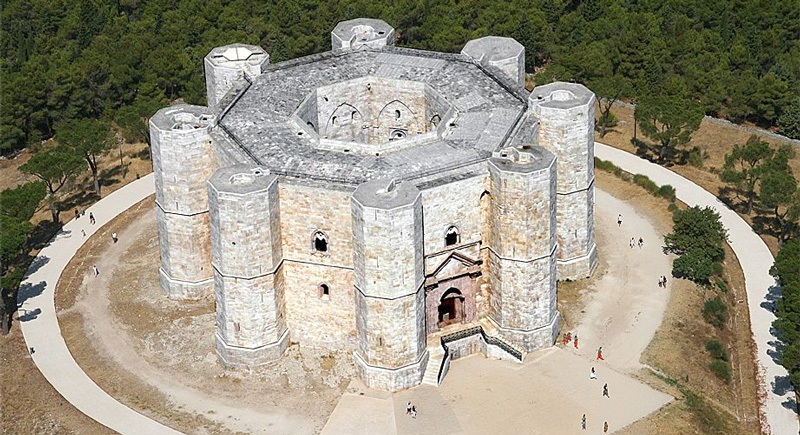
DAY 11 – NAPLES & POMPEI
Visiting Naples's historic centre means travelling through 20 centuries of history. The design of its streets, piazzas, churches, monuments, public buildings and castles constitute a jewel box of artistic and historical treasures of exceptional importance. Together, they earned their spot on the UNESCO World Heritage List in 1995. Naples is a real treasure of art and history, of indelible signs from past dominations, each of which has contributed to this city's construction.
The city dominates the Gulf of Naples, expanding from the Sorrentine Peninsula to the volcanic area of the Phlegraean Fields. The most famous Neapolitan piazza is Piazza del Plebiscito, displaying the grand colonnade designed by Gioacchino Murat; in front of it is the magnificent Royal Palace designed by Domenico Fontana. Castel Nuovo's different but well-integrated architectural lines, otherwise known as “Maschio Angioino”, evoke the double role of palace and fortress that this building played during the domination of the Anjou and Aragon families.
The churches in this city are countless. Over time, the Cathedral - erected upon pre-existing buildings, has undergone radical modifications to repair the damages caused by the earthquakes, especially on the outside. The interior hosts the famous “Cappella del Tesoro di San Gennaro” (“Chapel of St. Gennaro’s Treasure”), with the two vials containing the Saint's blood.
And last but not least, you will not miss the Sansevero Chapel, commonly called “Pietatella” (Little Pietà). Here you will be astonished by the “Cristo Velato” (Veiled Christ) by Giuseppe Sammartino, a masterpiece striking the eye with the extraordinary craftsmanship employed to sculpt the marble shroud over the body of Christ.
Naples is famous all over the world for its pizza. Yet, there is much more to this unique city’s culinary traditions. You will be pleasantly surprised by the variety and richness of flavours and recipes you’ll discover through our walking food tour. Your Guide will walk you into some of the best food venues in the city, known only to locals. Moving to the heart of the town, with its meandering streets and artisan shops, you will taste authentic mozzarella and try the best street food, such as pizza fritta or frittatina di maccheroni. Of course, we couldn’t do without a delicious bruschetta with Colatura di alici (a special dressing with origins dating back to Roman times). For an overview of Neapolitan cuisine read the article in our BLOG).
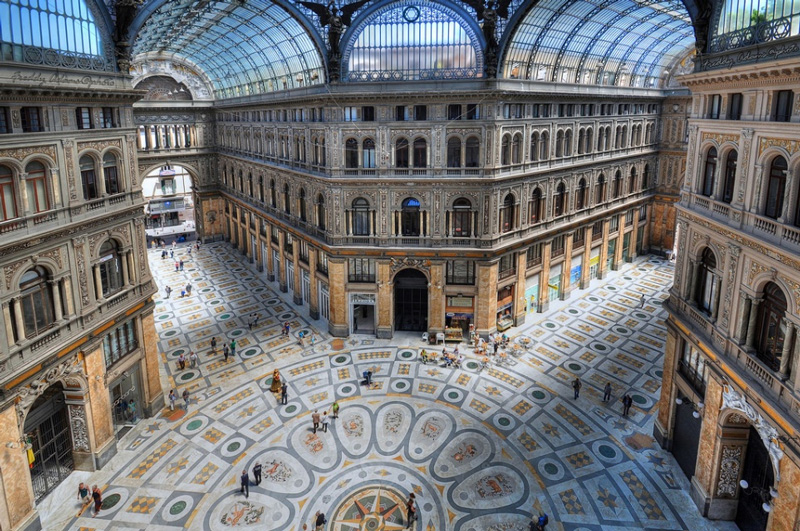
Pompeii, the Roman city excavated from the ashes of Vesuvius, has been a UNESCO World Heritage Site since 1997!
In 62 AD, the city was partially destroyed by an earthquake. As its reconstruction was still ongoing, on August 24, 79 AD, the eruption of Vesuvius covered the city and its suburban villas with a thick layer of stones, ashes and lapilli (thick, glassy lava). On the other hand, Herculaneum disappeared beneath a flood of volcanic mud.
The ruins of the ancient Roman cities offer an unparalleled window into the quotidian life of classical antiquity. Here you can understand how the Romans of the 1st century AD lived: from brothels and lavatories to posh dining rooms and bathing establishments, including modern spas, health clubs and gyms. The eruption of Mount Vesuvius destroyed the town in 79 AD, and the debris ejected by the volcano covered more than 3,000 people from the volcano.
Due to its healthy climate and pleasant scenery, Pompeii was a holiday resort for wealthy Romans. It is now famous for its civic buildings lining the streets, which are still intact today. The Surgeon’s House, the House of the Faun and the House of Chaste Lovers are exceptional examples of the epoch’s architecture. Another unique building is the House of Mysteries, deriving its name from the murals depicting the Dionysian cult's initiation rites (i.e., the mysteries).
A peculiar characteristic of Pompeii is the florid graffiti covering the walls in just about every building; when the volcanic eruption happened, Pompeii was set to carry out elections in the days ahead – hence the writings and ideograms, which feature both political and sexual content.
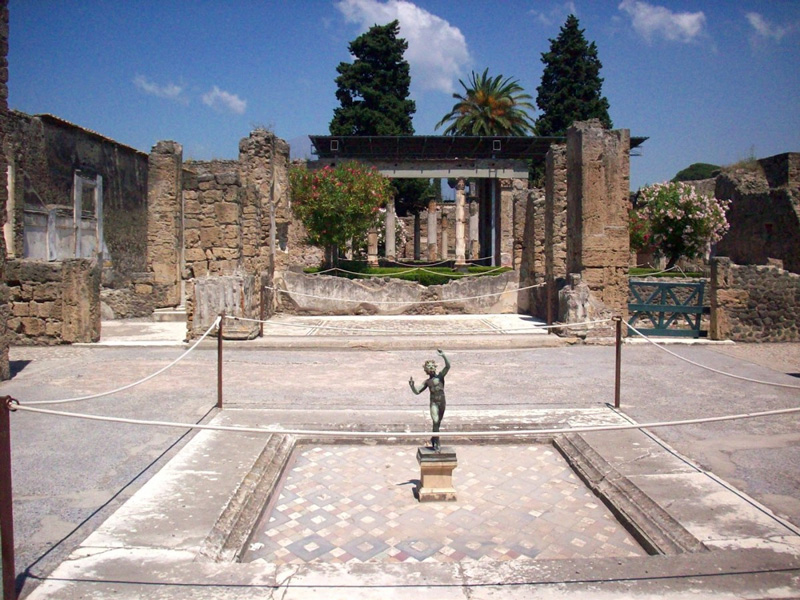
DAT 12 - TIVOLI
Discover one of Italy's hidden gems! Here is Tivoli, a small town about 30 Km east of Rome, boasting 2 of the most spectacular sites in Italy, Emperor Hadrian's Villa and Villa d'Este.
Emperor Hadrian built his villa to escape the crowd and turmoil of the capital. Much of the enormous, luxurious ancient villa remains intact today. You will be surprised by the innovative application of Renaissance plumbing in the fountains and waterworks, perfectly integrated with the landscape.
The other masterpiece in the area is Villa d’Este, the fantastic Villa commissioned by Cardinal Ippolito of the Este family around 1560. Among the masterpieces of the Italian Renaissance that most inspired landscape architects and painters, it is an ideal reinterpretation - in a sumptuous way - of the hanging Eden of Babylon. The prestigious residence is surrounded by terraces, stairways and avenues set on each other, decorated with water games so audacious as to reveal considerable engineering skills. The monument was elected the most beautiful park in Europe and UNESCO Heritage with the motivation: "one of the first gardens of wonders, which from the beginning had a decisive influence on the development of European landscape painting ».
The tour is over, but the memories of a fantastic journey will accompany you for a lifetime!
Arrivederci for another tour with VITOR, Visit Italy on the Road.
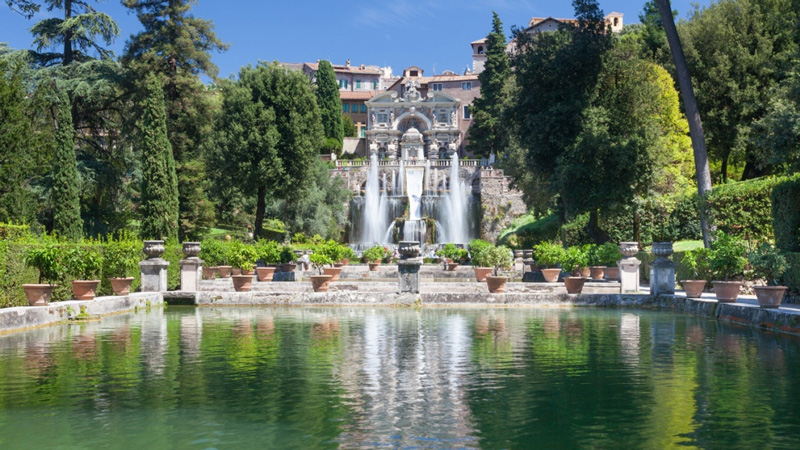
SUMMARY
- 5 Full Days + 5 Nights
- Type of tour: Circular
- Start and End in: Milan
WHAT'S INCLUDED
- 5 nights with European Breakfast
- 2 3-course dinners (wine not included)
- Private transportation in a comfortable air-conditioned van
- Private tour of Venice city centre with an Authorised Tourist Guide
- Admission to all locations mentioned
- All taxes and tips
DAYS1 & 2 – VENICE
Benvenuti in Italia, welcome to Italy.
Here you are in the “unique” Venice, the “city on the lagoon”, you will be astonished by its beauty and charm! You may start your visit with Piazza San Marco (St. Mark’s Square) and the interior of the Basilica, a 900 years old marvel of architecture! The church is unique in Italy for its golden Byzantine and Medieval mosaics, its intricate stone and marble traceries and exuberant Middle Eastern domes. Near St. Mark’s Basilica is Palazzo Ducale, the most impressive secular building in Venice and once the official residence of the supreme authority of Venice, the “Doge”. A masterpiece of Gothic architecture, the Doge’s Palace is an impressive structure composed of layers of building elements and ornamentation, from its 14th and 15th-century original foundations to the significant Renaissance and opulent Mannerist adjunctions.
At lunch, you may relax by tasting wine and savouring delicious "cicheti" (finger food). There is tremendous variety, and options include anything from simple cheese or salami to almost any kind of seafood, fried and grilled vegetables, sweet and sour sardines, creamy codfish and much, much more!
Then you may visit Santa Maria Gloriosa dei Frari (Saint Mary’s of Friars), striking for its huge size and for the quality of its works of art, including masterpieces by Titian, Giovanni Bellini and Donatello, and several grandiose tombs. Also, explore the streets and savour everyday life in an intricate maze of ancient narrow alleyways, lively squares with magnificent buildings and meandering canals, and finally walk on the Rialto Bridge, the busy "heart" of Venice. And last but not least, enjoy a Gondola ride on the city’s canals: a jump back in time, when Venetians moved only on the water.
Knowing what should be bought in Venice is not easy, as it is one of the most beautiful Italian cities. Rich in traditions, Venice presents a wide selection of souvenirs to take home as a souvenir of your trip. What you cannot miss among your purchases are the typical Venetian masks. The cost of the original ones is quite high, but it is really worth it! Another thing that should be bought in Venice is craftsmanship, appreciated worldwide. In the city of Italian carnival, it is a must to buy a Murano glass object. Each product is worked and painted by hand, but be sure you buy an original product from Murano, guaranteed by a label or a signature (and also by the seller), and not a Chinese copy!
Finally, at dinner you will be delighted by the flavours of the regional cuisine of Veneto, boasting delicious recipes such as "Sarde in saor”, Risotto with seafood, the typical “Baccala' mantecato”, to finish with a fantastic “Bussolà” (for an overview of the regional cuisine of Veneto see our BLOG).

DAY 3 – MODENA & MARANELLO
Modena is renowned worldwide for the famous people - Enzo Ferrari and Luciano Pavarotti above all - who were born and lived here, and for some of its gastronomical products. The city is the capital of the so-called “Motor Valley”: actually, the factories of the famous Italian sports car makers Ferrari, De Tomaso, Lamborghini and Maserati are located here.
The city of Modena hosts little jewels of art, such as the Romanesque Cathedral, wholly constructed with white marble and located in the heart of Modena, in Piazza Grande. The Piazza with the Cathedral and the Ghirlandina Tower is one of the 48 Italian sites on the UNESCO World Heritage List. The Ghirlandina, the bell tower rising majestically over the rooftops, derives from its marble balustrades around the steeple, suggesting the lightness of garlands.
In Maranello, you may visit Museo Ferrari, not just a collection of the past but an extraordinary experience of the world of Ferrari and sports car racing! How exciting to see the most beautiful cars in the world, exceptional artworks made by modern mechanic artisan masters.
Afterwards, you will move to the estate of a Balsamic Vinegar of Modena Producer, to delight in the unique, enticing taste of traditional balsamic vinegar. Balsamic Vinegar of Modena is obtained from partially fermented, cooked and concentrated grape must. The grapes come exclusively from the area's vines, and the most critical processing phase is refinement inside containers of fine wood, such as oak, chestnut, oak, mulberry and juniper. Want to know more about this unique delicacy? Read the article in our BLOG.
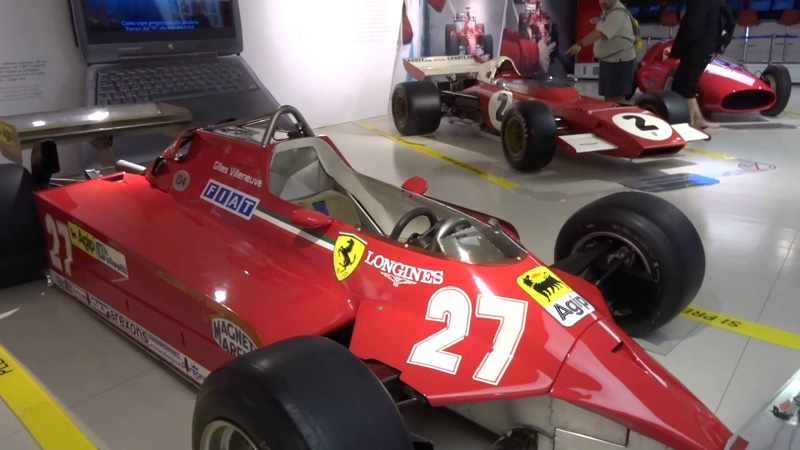
DAY 4 – FLORENCE
IWelcome to Florence, the land of Dante, Leonardo da Vinci and Giotto!
Despite its international fame and greatness, Florence is also a small city, whose history is interwoven with that of its passionate citizens for more than one thousand years.
In Piazza Duomo you will be astonished by the Duomo, with the incredible Brunelleschi’s cupola, a masterpiece of art and architecture whose building techniques building are still covered with a veil of mystery. Beside it, Giotto’s Campanile (Belltower) and the Baptistery, one of the oldest buildings in the city, with its famous bronze doors made by Pisano and Ghiberti in the 14th and 15th centuries. In Piazza della Signoria you will walk in the middle of bronze and marble masterpieces by Giambologna and Cellini inside the marvellous Loggia dei Lanzi, and will admire the imposing Palazzo Vecchio, one of the symbols of Florence and still the seat of government of the city. You may also spare some time to relax, visiting a typical market for shopping, strolling through the pedestrian streets of the city and crossing the oldest bridge in Florence, “Ponte Vecchio” (Old Bridge), rich of jewellery shops.
Our itinery include the visit to the Uffizi Gallery, one of the most famous museums in the world for its extraordinary collections of paintings. Here you will admire works by Botticelli, Michelangelo, Leonardo da Vinci, Caravaggio and a lot more. Also, you should not miss Galleria dell’Accademia, hosting Michelangelo's David, the most famous sculpture in the world!
At lunch, enjoy “Panino con Lampredotto” in a typical Florentine market, while for dinner move to Oltrarno where Florentines like to dine. Here you may taste the simple yet unforgettable recipes of the Tuscan tradition, such as "Crostini", "Panzanella" and "Peposo". And remember, Florence is the home of "Fiorentina" steak! In case you are a vegetarian, don’t worry: Tuscan cuisine offers tasty alternatives like “Pappa al Pomodoro” or “Ribollita” (for an overview of Tuscan cuisine see our BLOG).

DAY 4 – PISA
Pisa is famous worldwide for its “Torre Pendente” (Leaning Tower), but its wonderful square, Piazza dei Miracoli, set over an ample greenfield, hosts three other whiter-than-white masterpieces of exquisite Medieval art: the Cathedral, the Baptristy and the “Camposanto” (Graveyard). They are so unique that their creation originated a new style, "Pisan Romanesque".
This area was chosen to construct the Duomo of Santa Maria Assunta strictly for its centrality; founded in 1064, it was intended to celebrate the grandeur of Pisa during the Marine Republic’s epoch of power. "The temple of marble white as the snow"; that’s how the structure is described on the gravestone of its architect, Buscheto di Giovanni Giudice. Consisting of five naves with its transept divided into three naves, it is surmounted by a splendid dome encircled by a loggia. The Duomo’s façade and exterior lateral sections feature elaborate decoration in marble (which can also be seen on its interior), mosaics, and bronze.
In front of the Cathedral stands the Baptistry, also in a particular version of the Romanesque style. Initiated in 1152 by Diotisalvi, the Baptistry was finally completed in the 14th century; Gothic elements were added then. Of cylindrical form and circled by arcades of columns, this structure in white marble even boasts impressive acoustics.
The Camposanto closes the northern end of the complex's piazza. This monumental cemetery, begun in 1278, is bordered by a marble fence and houses a cloister at its centre. Unfortunately, most frescoes that once coloured its walls were destroyed in a fire in 1944 during the battle for Pisa.
Ultimately, the true symbol of Pisa is the Campanile, the Leaning Tower, which completes the image of this city. Because of land sinkage beneath it, the Tower stands at a significant incline. Its construction started in 1173, but the Tower was not completed until the second half of the 1300s. In cylindrical form, the blind arcades of its lower part mutate into six floors of loggias, repeating motifs from the Duomo. Inside, a spiral staircase of 294 steps leads to the heights of one of the most famous towers in the world, where the lovely belfry and a spectacular view of the surrounding landscape await.

DAY 5 – SIENA & SAN GIMIGNANO
In Siena, the city of the Palio, you will walk on the famous Piazza del Campo, the concave square where horses run twice a year in a dangerous race that symbolizes the city’s freedom. On the days of the Palio, the whole town goes crazy; read about it in our BLOG. Indeed, you will not forget the colour of frontages and roofs, the renowned colour “Sienna”, a pigment first produced during the Renaissance, that makes the city lovely and warm. And don’t forget to taste the Senese sweets: “cantucci” (biscuits with toasted almonds), “ricciarelli” (soft biscuits with icing sugar), “panforte”(cake with fruit nuts and spices) and “cavallucci” (biscuits with honey, walnut, candied fruits and spices. Travellers who love dessert will be delighted!
In the afternoon, you will stroll with your head upwards along the streets of one of the most beautiful cities in Tuscany, San Gimignano, also known as the "Medieval Manhattan", thanks to its old and impressive 14 towers that dominate the town skyline. Originally the towers were 72, built by patrician families probably to demonstrate their wealth and power. Seven of San Gimignano's towers are around Piazza del Duomo; the tallest one is Torre Grossa, 54 meters high, dating back to 1298.

DAY 6 – VAL D’ORCIA
Val d’Orcia is one of the most fascinating places in Italy, included by UNESCO in the list of World Heritage Sites. Its landscape is a part of the agricultural hinterland of Siena, redrawn and developed when it was integrated into the city-state's territory in the 14th and 15th centuries to reflect an idealized model of good governance and create an aesthetically pleasing picture. The landscape’s distinctive aesthetics, flat chalk plains with almost conical hills and fortified settlements on top, inspired many artists. Their images have come to exemplify the beauty of well-managed Renaissance agricultural landscapes.
Your first stop will be in Pienza, “Pio’s town”: here, Pope Pius II decided to build the perfect palazzo for his papal court according to the project of an “Ideal City" drawn up by artists such as Piero della Francesca. From the loggia of the Palace, you will enjoy a breath-taking panorama of the valley. Pienza is also the area of the typical “Pecorino di fossa” cheese, an absolute delight to the palate!
In Montepulciano, our friend Francesca will lead you to discover this beautiful town full of stories, legends and thousand flavours, introducing you to the excellent products of this unique land: olive oil, pecorino cheese and Vino Nobile di Montepulciano.
Then, you will get to Montalcino, one of the prettiest hill towns in Tuscany. Around the village, rows of olive trees, precious grapevines and yellow fields create an enchanting landscape. Here you may visit a Brunello winery to taste the most famous SupertuscanSupertuscan wine, probably the best Italian red!
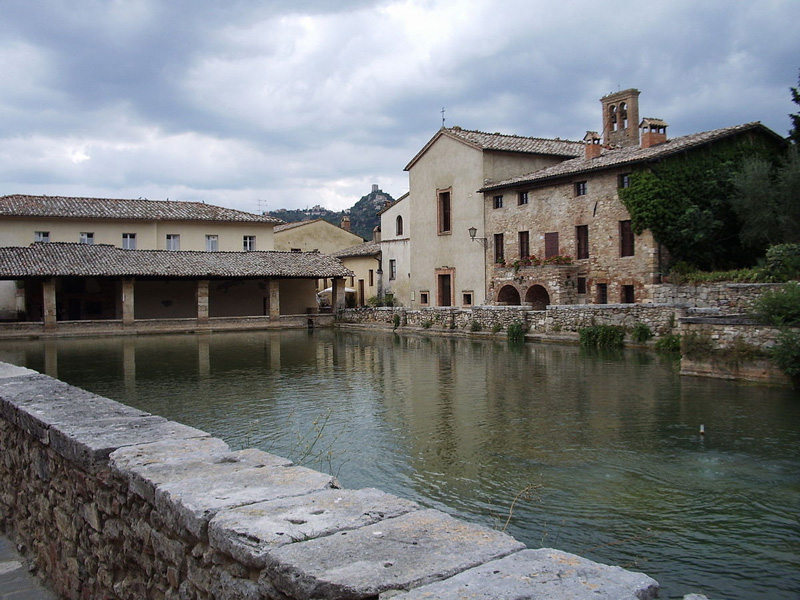
DAY 7 – ROME
Here you are in Rome, where ancient history, excellent art and religious icons mix uniquely! Start from the 2,000-year-old Colosseum, the most famous amphitheatre in the world, and the Imperial Fora, the administrative and monumental centre of the Roman Empire. On the Palatine Hill, the majestic ruins of the Palaces of Augusto, Tiberius and Domiziano still dominate theCircus Maximus valley, 50-meter-high structures giving a unique view of the city.
Close to the Colosseum, inside the Church of San Pietro in Vincoli, you may see the famous Michelangelo sculpture of “Moses”. Supposedly, Michelangelo, admiring his Moses, enraptured by the so realistic shapes of the imposing statue, was struck by a violent outburst of anger and exclaimed the famous phrase “Perchè non parli?" (Why don't you speak!?)
From Piazza Venezia, you will head inside “Baroque” Rome, starting with the Pantheon, dedicated to worshipping every god (Pan-every Theon-divinity), now the memorial chapel of great Italian people of the past. After that, don’t miss the Church of St. Louis of the French, famous for the cycle of paintings of the great Caravaggio at the end of the 16th century. Then Piazza Navona, the splendid oval area corresponding to the underground Domitianus’ Stadium, with the gorgeous Fountain of the Four Rivers by Lorenzo Bernini in the centre of the Piazza. And finally, Fontana di Trevi, the city’s biggest and most famous fountain, a Rome icon renowned worldwide: here, statues of travertine marble stand over the cliff and the broad basin in an epic representation of the Kingdom of the Oceans.
At the end of the day, sit down at a local "trattoria" or "fiaschetteria", the typical home-style restaurant, to taste authentic Roman cuisine in a popular and cheerful atmosphere (for an overview of Roman cuisine, see our BLOG).
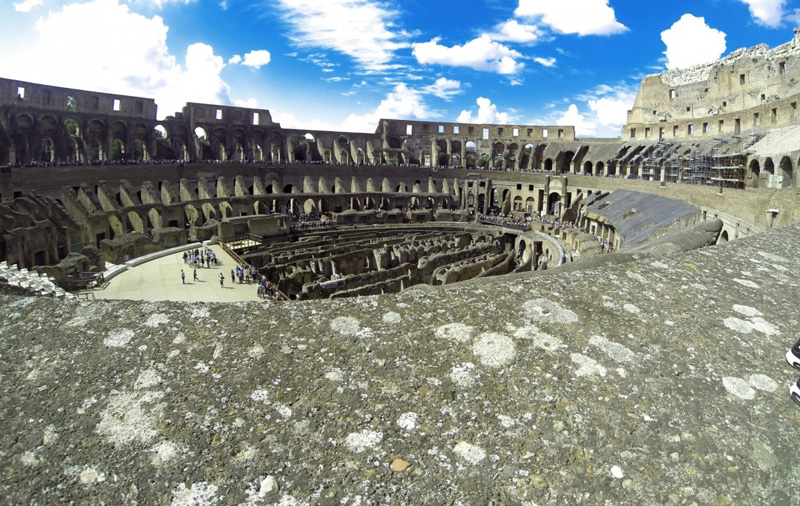
DAY 8– VATICAN CITY
On the other side of River Tevere, Vatican Hill is the home of the tiny state of Vatican City. The immense St. Peter’s Basilica dominates the extraordinary Piazza framed by the magnificent four-column-deep colonnades designed by Gian Lorenzo Bernini. The Basilica is an extraordinary casket for some of the world's most beautiful works of art, such as Michelangelo’s “La Pietà” and Bernini’s “Baldacchino”, along with works of the most important artists of the Renaissance, from Raphael to Canova.
Inside the Vatican Museums, you will be astonished by the exquisite and unique Sistine Chapel, the “Sancta Sanctorum” (“Holy among the Holiest” in Latin) of the Roman Catholic Church, where cardinals gather to elect the new Pope! The Sistine Chapel takes its name from Pope Sixtus IV della Rovere (pontiff from 1471 to 1484), who had the old Cappella Magna restored between 1477 and 1480. The decoration of the walls was executed by a team of painters, Pietro Perugino, Sandro Botticelli, Domenico Ghirlandaio and Cosimo Rosselli, assisted by their respective shops.
Julius II della Rovere (pontiff from 1503 to 1513), the nephew of Sixtus IV, decided to partly alter the decoration, entrusting the work in 1508 to Michelangelo Buonarroti, who painted the Ceiling and, on the upper part of the walls, the lunettes. The nine central panels show the Stories of Genesis, from the Creation to the Fall of Man, to the Flood and the subsequent rebirth of humanity with the family of Noah. Again, towards the end of 1533, Clement VII de' Medici (pontiff from 1523 to 1534) asked Michelangelo to paint the Last Judgement on the altar wall. How could he refuse? And, in fact, he did not, but painted his vision of the Judgement, with a powerful and furious Jesus Christ.
The tour is over, but the memories of a fantastic journey will accompany you for a lifetime!
Arrivederci for another tour with VITOR, Visit Italy on the Road.

DAYS 9 & 10 – AMALFI COAST
Costiera Amalfitana is Italy's most scenic stretch of coastline, a landscape of pastel-coloured villages terraced into hillsides, steep panoramic roads, luxuriant gardens and enchanting vistas over turquoise waters and green mountains.
Considered by UNESCO "an outstanding example of a Mediterranean landscape, with exceptional cultural and natural scenic values," the coast has been a World Heritage Site since 1997. You may go from town to town at the discovery of Amalfi, Positano, and Ravello, three of the most beautiful villages in Southern Italy, world-famous for their charm and colourful architecture.
Amalfi typically has Mediterranean architecture with lanes and characteristic white houses piled one upon the other. In the Middle Ages, it was one of Italy's four powerful maritime republics (with Venice, Pisa, and Genoa). All sea trade in the Mediterranean was once governed by the 12th century “Tavole Amalfitane”, one of the world's oldest maritime codes. A must-see in Amalfi is the Duomo di Sant'Andrea, fronted by an intricately patterned façade, redone in the 19th century. Founded in the 9th century, the Cathedral's subsequent alterations have spared its principal glory, the main portal's 11th-century Byzantine bronze doors. Next to the church lies the Chiostro del Paradiso (1268), or Cloister of Paradise, whose serious Romanesque tone is animated by the Arab elements in its sinuous columns. To escape the bustle of Amalfi, let’s take the famous walk along the “Valle dei Mulini”, a steep-sided valley dotted with ruined watermills – “i mulini” - once used to make paper, an industry for which Amalfi was, and still is, famous.
Positano sits in a splendid panoramic position on one of the most beautiful stretches of coastline. Its enchanting town centre of delightful pastel-coloured houses surrounds the parish church of Santa Maria Assunta; its streets are lined with quaint, colourful shops, and its numerous beaches are world-famous.
Ravello is more elevated than the other pearls of the Amalfi Coast, boasting exceptional views of the coast and its marvellous villas and gardens. French novelist André Gide said they are “closer to the sky than the sea”. Here you may visit Villa Rufolo, built in the 13th century, which hosted popes and kings, and Richard Wagner, who composed part of his opera Parsifal here in 1880. Views from its idyllic gardens are magnificent!
A trip to Cetara is an absolute must. The village is renowned for a particular gourmet speciality, “colatura di acciughe” (anchovy sauce), produced according to an ancient procedure for generations. Spaghetti with colatura di alici is the area's typical recipe, a dish you will remember forever. Discover the secrets of the liquid gold of the Coast in the article in our BLOG.
At dinner, don’t miss Spaghetti with clams in olive oil and garlic sauce, or Seafood Risotto, with a glass of excellent Greco di Tufo white wine.

DAY 11 – POMPEI
Pompeii, the Roman city excavated from the ashes of Vesuvius, has been a UNESCO World Heritage Site since 1997!
In 62 AD, the city was partially destroyed by an earthquake. As its reconstruction was still ongoing, on August 24, 79 AD, the eruption of Vesuvius covered the city and its suburban villas with a thick layer of stones, ashes and lapilli (thick, glassy lava). On the other hand, Herculaneum disappeared beneath a flood of volcanic mud.
The ruins of the ancient Roman cities offer an unparalleled window into the quotidian life of classical antiquity. Here you can understand how the Romans of the 1st century AD lived: from brothels and lavatories to posh dining rooms and bathing establishments, including modern spas, health clubs and gyms. The eruption of Mount Vesuvius destroyed the town in 79 AD, and the debris ejected by the volcano covered more than 3,000 people from the volcano.
Due to its healthy climate and pleasant scenery, Pompeii was a holiday resort for wealthy Romans. It is now famous for its civic buildings lining the streets, which are still intact today. The Surgeon’s House, the House of the Faun and the House of Chaste Lovers are exceptional examples of the epoch’s architecture. Another unique building is the House of Mysteries, deriving its name from the murals depicting the Dionysian cult's initiation rites (i.e., the mysteries).
A peculiar characteristic of Pompeii is the florid graffiti covering the walls in just about every building; when the volcanic eruption happened, Pompeii was set to carry out elections in the days ahead – hence the writings and ideograms, which feature both political and sexual content.
The tour is over, but the memories of a fantastic journey will accompany you for a lifetime!
Arrivederci with another tour at the discovery of Italy with VITOR, Visit Italy on the Road.
